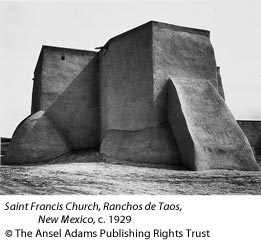|
Saint Francis Church, Ranchos de Taos, New Mexico, c. 1929
Plate 32 in Ansel Adams - Classic Images
Main Source: Examples - The Making of 40 Photographs by
Ansel Adams, pp 90-93
A. What impressed Adams about this
structure?
B. Why was this church included in his book Taos Pueblo?
C. What role did intuition play in this photograph and
other by Adams?
D. How did Adams achieve such extraordinary luminosity?
E. Did Adams follow archival procedures?
F. Technical Aspects
G. Related links in this site
A. What impressed Adams about this structure?
When he first saw the church, Adams was impressed by it's "magnificent
form" and its "rigorous and simple design and structure."
The photograph of this church was shot from the rear, which was the
angle that Adams thought made it "one of the great architectural
monuments of America." He wrote in Elements, "it is
not really large, but it appears immense. The forms are fully functional;
the massive rear buttress and the secondary buttress to the left are
organically related to the basic masses of adobe, and all together seem
an outcropping of the earth rather than merely an object constructed
upon it."
...back to top
B. Why was this church included in his book Taos Pueblo?
First published in 1930, Taos Pueblo included twelve original prints
by Adams and text by Mary Austin. Though this church is not actually
in the Pueblo, it held significance for the entire area. Constructed
in 1776, it is in the little Mexican American settlement of Ranchos
de Taos a few miles south of the Pueblo. It had been interpreted by
many painters and photographers, and Adams said he could not resist
the challenge.
...back to top
C. What role did intuition play in this photograph and other by
Adams?
Adams wrote in Elements, "We should never deny the power
of intuition or hesitate to follow its revelations... It is essential
that the artist trust the mechanisms of both intellect and creative
vision. The conscious introspective critical attitude has no place in
the luminous moments of creative expression, but should be reserved
for later, when the work is complete." He stated, "I seemed
to know precisely the square yard of earth on which to place my tripod."
He said, "Some intuitive thrust made this picture possible."
...back to top
D. How did Adams achieve such extraordinary luminosity?
Adams stated in Elements that "this image is an experience
in light." He described how he had used yellow and red filters
before in many images in special high-altitude light of the Southwest.
"But on this occasion some gentle angel whispered 'no filter' and
I obeyed." Taking the shot with no filter allowed the blue sky
to appear quite light, and the shadows were softened... A darker sky
would have depreciated the feeling of light." He asks a good question
himself: "What mechanism of the eye and mind selects patterns and
relationships in an unfamiliar world about us and composes them as expressive
images?" He doesn't claim to have the answers.
...back to top
E. Did Adams follow archival procedures?
Adams chose the highest quality paper and equipment and held to
the most rigorous standards of his craft from taking the photograph
to making the print. "But," he wrote in Elements, "in
those days we were not aware of archival procedures. Countless formulas,
many based on bathtub chemistry, and arcane procedures flourished, and
a few were effective."
...back to top
F. Technical Aspects
- Camera: 6 1/2 X 8 1/2 Korona View
- Lens: 8 1/2 inch Tessar-type lens
- Film: orhochromatic (sensitive only to blue and green light)
- Filter: none
- Paper: Dassonville Charcoal Black on mildly textured rag paper of
highest quality Developer Amidol
...back to top
G. Related links in this site
- Resources
- See Bibliography for more material by and about Ansel Adams.
For more information on the technical aspects - cameras, films,
lenses, filters, darkroom techniques, printing, papers, etc. -
please refer to Examples, The Making of 40 Photographs
by Ansel Adams (Boston, Toronto, London: Little, Brown and Co,
1983).
- About Photography
- See Glossary for definitions
of vocabulary words and photographic terms.
|
